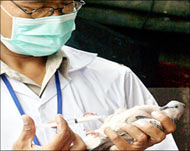Indonesia mobilises against bird flu
Hundreds of Indonesians in protective gear are hunting sick fowl across the bird-flu-hit capital Jakarta, while France confirms the presence of a flu virus at a turkey farm.

Bird flu has spread rapidly across Europe this month but so far it had affected only wild birds. Newly infected Nigeria, Egypt and India have had major outbreaks in poultry.
If confirmed, the French case on Friday would mark the first time the H5N1 virus had spread to domestic fowl in the European Union and could deal a further blow to France’s already battered poultry industry, worth $7 billion a year.
In Jakarta where backyard chickens are common, about 600 inspectors sprayed disinfectant in bird cages and chicken coops.
Sutiyoso, Jakarta’s governor, launched a campaign to stamp out the virus and said: “We need cooperation from the people. In any case, we have to choose our own safety, and the life of the people, rather than fowl, including singing birds.”
Human cases
Bird flu has killed at least 19 people in Indonesia, the second highest toll in the world after Vietnam, and the H5N1 virus is now present in 26 of the country’s 33 provinces.
Many of the human cases have been in or around the capital.
 |
|
An agriculture ministry worker |
Health workers launched their own clean-up campaign in western India after the country’s first outbreak.
Officials said vets began cleaning up chicken farms and disinfecting homes in a remote western town after culling hundreds of thousands of chickens.
Health officials said fears of human infections were easing as 11 of 12 people quarantined had tested negative. The last sample had to undergo further tests to conclusively decide its status. The result was expected on Saturday.
Two more people have also been quarantined, including a veterinary worker involved in culling in Navapur, Maharashtra, where India’s first H5N1 outbreak in chickens was confirmed last week.
H5N1 has accelerated its march across the globe, spreading to at least 16 more countries this month and the World Health Organisation believes migratory water fowl are one of the main carriers.
Mutated strain
Europe is preparing for more cases as the spring migration approaches and new species, possibly already infected, arrive from Africa.
On Friday, Cambodia said bird flu had returned after the virus was found in dead ducks near the border with Vietnam.
 |
|
A mass cull is under way |
Four people died of bird flu in Cambodia after it first arrived in late 2003 and its re-appearance was the first in months in a region experts believed could generate a mutated virus that might trigger a global human pandemic.
H5N1 has killed at least 92 people out of 170 infected since 2003 but it remains hard for people to catch. Experts fear it is only a matter of time before it changes into a form that passes easily between humans.
Health experts say the more the virus spreads and infects poultry, the greater the chances of human infections that might lead to the feared mutated strain.
Risk factors
So far the biggest risk seems to be for people who come into direct contact with sick chickens.
Experts say that in Africa, where chickens live in millions of homes, the virus could spread rapidly and largely undetected due to a lack of health, veterinary and laboratory services.
They hold similar fears for India, where millions of people live in rural areas side-by-side with livestock and domestic fowl.
Indonesia is no different. Keeping backyard chickens is part of the culture and exotic birds are also a status symbol.
Government officials put the number of backyard poultry in Indonesia at 370 million, half a million alone in the densely populated capital. And, although new infections in fowl dropped significantly last year from the previous year, the number of cases among humans has risen in the past six months.